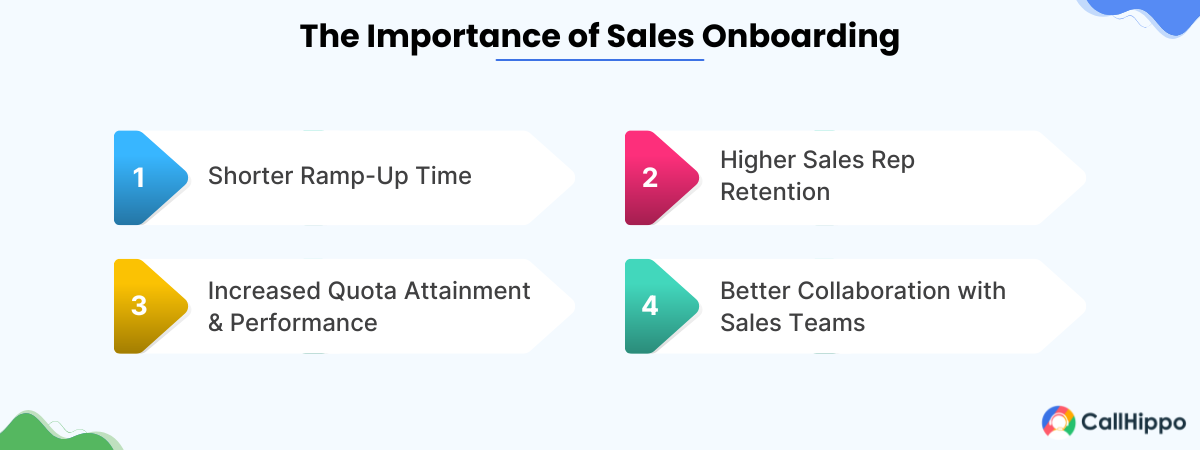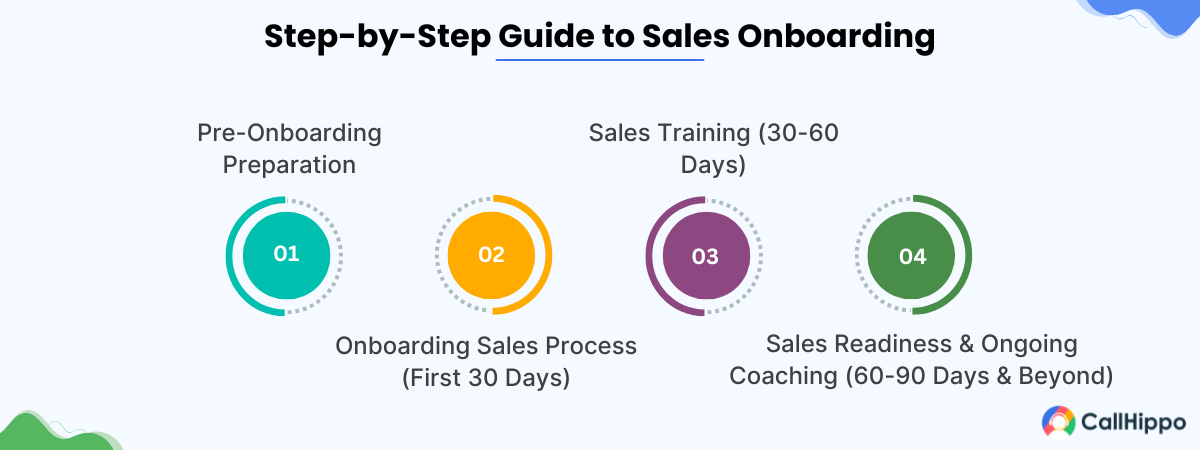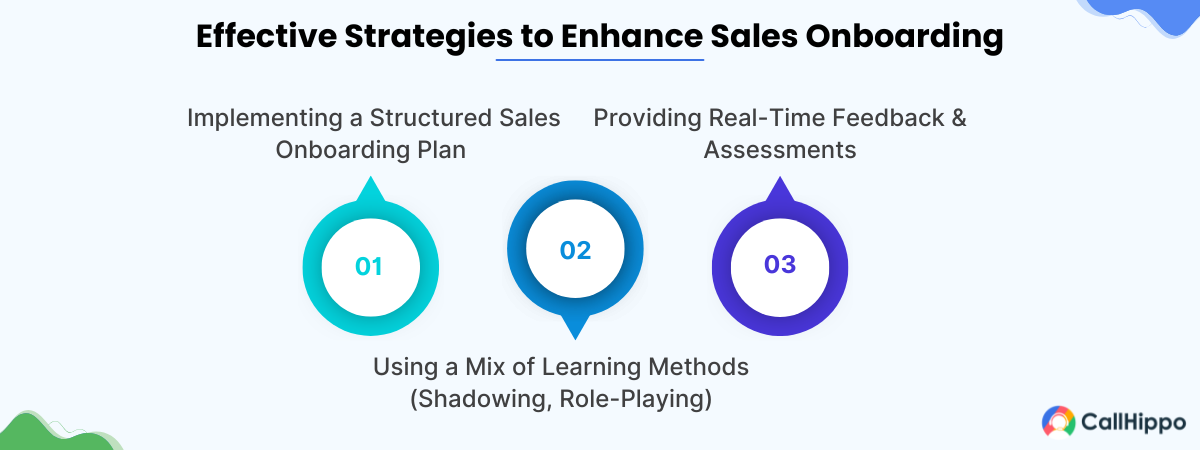Without the right guidance, even the most talented sales reps can struggle to find their footing. That’s where sales onboarding comes in! A well-designed onboarding process helps new hires quickly understand your products, sales strategies, and company culture—setting them up for success from day one.
A well-structured sales onboarding process improves productivity, increases retention, and ensures long-term success. This detailed blog will cover the sales onboarding definition, the sales onboarding plan, and sales onboarding best practices to help organizations optimize their strategy. So let’s get started.
What Is Sales Onboarding?
Sales onboarding is the structured process of integrating and training new sales representatives to ensure they become productive and confident in their roles. A well-executed sales onboarding plan includes product knowledge, sales techniques, and tools training to help sales reps achieve their targets efficiently.
Pro-Tip
Combining structured training, hands-on practice, and mentorship accelerates ramp-up time and improves retention.
Regularly update your sales onboarding checklist to align with evolving sales strategies and market trends.
Why Sales Onboarding Matters?
An effective sales onboarding program is essential for business success. It shortens the learning curve, enhances sales performance, and reduces turnover. Below are the key benefits of a well-designed sales onboarding process:

1. Shorter Ramp-Up Time (Faster Time-to-Productivity)
One of the biggest challenges in sales hiring is the ramp-up period—the time it takes for a new sales rep to become fully productive. Without a structured onboarding sales process, new hires often struggle with product knowledge, sales tools, and understanding customer needs, delaying their ability to generate revenue.
A well-designed sales onboarding template shortens this learning curve by:
- Providing structured training sessions that focus on essential skills like prospecting, pitching, and closing deals.
- Offering hands-on experience with CRM tools, sales enablement platforms, and communication channels.
- Assigning mentors or onboarding buddies to guide new reps and answer their questions in real time.
- Incorporating role-playing exercises and call coaching to boost confidence in handling customer interactions.
By streamlining the sales onboarding process, companies enable new hires to achieve quota readiness faster, reducing the time from hiring to revenue contribution.
2. Higher Sales Rep Retention & Job Satisfaction
High turnover in sales roles is a costly issue for businesses. When sales reps don’t receive proper training and support, they often feel overwhelmed, unprepared, and disengaged—leading them to leave within the first few months. A structured sales onboarding plan significantly improves employee retention and job satisfaction by ensuring reps feel valued, supported, and equipped for success.
A successful sales onboarding definition includes the following:
- Clear expectations from day one so new hires understand their goals and responsibilities.
- A well-defined learning path allows reps to gradually build their skills rather than feel pressured to perform immediately.
- Regular feedback sessions with managers to address challenges and provide personalized guidance.
- Opportunities for career growth, including continued training, skill development, and leadership pathways.
When new hires feel empowered and supported, they are more likely to stay with the company, reducing recruitment costs and improving team stability.
3. Increased Quota Attainment & Performance
A well-executed sales onboarding process directly impacts revenue growth by improving new hire performance. When sales reps receive proper training and mentorship, they develop the skills needed to meet or exceed their sales quotas consistently.
Effective sales onboarding best practices focus on the following:
- Comprehensive product training, ensuring reps can confidently communicate the value of the company’s offerings.
- Hands-on practice with sales methodologies, including consultative selling, solution-based selling, and objection handling.
- Data-driven performance tracking, where managers monitor key sales metrics and provide actionable insights.
- Continuous learning opportunities, such as advanced negotiation training and peer coaching, to refine skills over time.
Sales reps who are well-trained and continuously supported are more likely to hit their quotas, drive revenue, and contribute to the company’s growth.
4. Better Collaboration with Sales Teams
Sales success is rarely an individual effort—it requires strong team collaboration and alignment with other departments, such as marketing and customer success. A structured sales onboarding checklist ensures that new hires integrate seamlessly into the team, fostering a culture of knowledge sharing and support.
A collaborative sales onboarding process includes:
- Cross-functional training, where sales reps learn from marketing, product, and customer success teams to better understand the full customer journey.
- Team-building activities, such as group coaching sessions and role-playing exercises, strengthen peer relationships.
- Mentorship programs, where experienced reps help new hires navigate challenges and share best practices.
- Regular sales meetings, ensuring alignment on strategies, goals, and market insights.
When sales reps feel connected to their team and aligned with company goals, they work more effectively, leading to higher team productivity and stronger customer relationships.
DID YOU KNOW!
- Sales reps who go through the best sales onboarding programs are productive 3-4 months sooner, on average, than those who are onboarded at organizations with weaker programs.
Source
The Sales Onboarding Process: Step-by-Step Guide
A well-structured sales onboarding checklist helps organizations streamline the sales onboarding process and set new hires up for success. The following step-by-step guide outlines key phases in an effective sales onboarding program.

1. Pre-Onboarding Preparation
Before a new sales rep officially starts, organizations must lay the groundwork to ensure a seamless transition. This includes setting clear expectations regarding their role, responsibilities, and performance benchmarks. Companies should also gather and provide necessary documents, such as sales playbooks, compensation plans, product catalogs, and CRM access credentials.
Another crucial step is assigning mentors or onboarding buddies, experienced team members who can offer guidance, answer questions, and help the new hire integrate smoothly into the sales culture. This proactive approach creates a strong foundation, reducing uncertainty and enhancing engagement from day one.
2. Onboarding Sales Process (First 30 Days)
The first 30 days focus on familiarizing new sales reps with the company, its target market, and product offerings. The orientation and company overview provide an introduction to the company’s mission, values, and sales culture, helping new hires understand the organization’s goals and expectations. Sales reps also need to develop a deep understanding of the target market and ideal customer profile (ICP) by studying buyer personas, industry pain points, and customer behaviors.
This knowledge enables them to tailor their sales approach effectively. Additionally, learning about product knowledge and competitive analysis is essential. Sales reps must be well-versed in product features, benefits, and differentiators to position offerings competitively and handle objections confidently. A strong grasp of these fundamentals empowers new hires to engage with prospects more effectively.
3. Sales Training (30-60 Days)
In the second month, training intensifies with hands-on learning. One of the first areas of focus is CRM and sales tools training, where reps are introduced to the company’s sales technology stack, including CRM platforms, lead management tools, and automation software. Mastering these tools improves efficiency and helps reps track and manage customer interactions effectively.
Next, reps undergo sales process overview and methodology training, where they learn about the company’s structured sales cycle, from lead generation to closing deals. This includes sales frameworks such as SPIN Selling, Challenger Sales, or Solution Selling, which guide their approach.
Effective questioning techniques increase deal closure rates.
-Neil Rackham, creator of SPIN Selling
4. Sales Readiness & Ongoing Coaching (60-90 Days & Beyond)
Beyond the initial onboarding period, ongoing coaching and skill reinforcement play a crucial role in long-term sales success. Call coaching and role-playing exercises allow sales reps to practice real-world sales scenarios, refine their pitch, and receive constructive feedback from managers. These exercises help reps improve objection handling and build confidence in their communication skills.
Additionally, 1-on-1 peer coaching facilitates knowledge sharing and mentorship, allowing new hires to learn from experienced sales professionals who can provide valuable insights and best practices. Lastly, continuous learning through on-demand training ensures that sales reps stay updated on evolving sales strategies, market trends, and product updates.
How to Improve the Sales Onboarding Process?
An effective sales onboarding process plays a critical role in ensuring that new sales reps become productive quickly. However, many organizations struggle with inefficient or inconsistent onboarding, leading to high turnover rates and longer ramp-up times. To optimize the sales onboarding process, companies should focus on structured planning, diverse learning methods, and continuous feedback.

1. Implementing a Structured Sales Onboarding Plan
A well-organized sales onboarding plan is the foundation of a successful onboarding program. Without a structured approach, new hires may feel overwhelmed, leading to lower engagement and poor retention. A sales onboarding template can help organizations standardize the training process, ensuring consistency and effectiveness.
Key elements of a structured sales onboarding plan include:
- Clearly Defined Goals: Set measurable objectives, such as reaching a certain number of calls.
- Timeline-Based Training Modules: Break the onboarding process into phases—pre-onboarding, first 30 days, 30-60 days, and 60-90 days—so that new hires progress systematically.
- Assigned Mentors and Coaches: Pairing new hires with experienced sales reps or managers helps them navigate challenges and accelerates their learning curve.
- Performance Milestones: Set checkpoints at 30, 60, and 90 days to assess progress and ensure new hires are on track.
2. Using a Mix of Learning Methods (Shadowing, Role-Playing)
Sales onboarding should not be limited to presentations and reading materials. To improve retention and engagement, companies must incorporate a variety of learning methods, including hands-on experiences.
One of the most effective ways to learn is by observing top-performing sales reps in action. New hires should listen to sales calls, watch live demos, and attend client meetings to understand real-world selling techniques. Moreover, practicing sales conversations in a controlled environment helps new hires refine their approach, handle objections, and build confidence. Role-playing can simulate cold calls, product demos, and negotiation scenarios.
By combining different learning methods, companies can cater to different learning styles and ensure a comprehensive understanding of the sales process.
Effective sales onboarding goes beyond training materials—it should immerse new hires in real-world scenarios. Encourage shadowing top sales reps, practicing objections, and engaging in role-playing to build confidence and competence quickly.
3. Providing Real-Time Feedback & Assessments
Regular feedback and assessments are essential to identifying knowledge gaps and ensuring that new sales reps are progressing effectively. Without timely feedback, new hires may develop bad habits or struggle with critical aspects of the sales process.
Managers should listen to recorded or live sales calls and provide immediate feedback on tone, messaging, and objection handling. Constructive feedback helps reps improve their approach before interacting with real customers.
Providing continuous, real-time feedback ensures that sales reps remain aligned with company expectations and are well-prepared for success in their roles.
Sales Onboarding Best Practices for Success
A well-structured sales onboarding process is critical to setting new hires up for success. Without a clear plan, sales reps may struggle to understand expectations, leading to lower productivity, disengagement, and even early turnover.
By following sales onboarding best practices, organizations can ensure new hires ramp up quickly and contribute to revenue growth. One of the most effective ways to streamline onboarding is by implementing a sales onboarding checklist that outlines key steps, activities, and milestones for each phase of onboarding.
Create a Sales Onboarding Checklist
A sales onboarding checklist serves as a roadmap for new hires, ensuring they receive the necessary training and resources at the right time. It also helps sales managers track progress and ensure consistency across the onboarding experience.
A well-designed checklist includes key steps and activities at each phase of the onboarding sales process while incorporating measurable milestones to track progress.
Key Steps & Activities at Each Onboarding Phase
A structured sales onboarding template typically consists of four main phases:
1. Pre-Onboarding (Before Day 1)
Pre-onboarding sets the foundation for a smooth transition into the company. It ensures new hires feel prepared and engaged even before they officially start.
- Send welcome emails with company information, job expectations, and required paperwork.
- Provide access to internal resources like sales playbooks, company policies, and CRM training materials.
- Assign a mentor or onboarding buddy to guide the new sales rep through the first few months.
- Schedule introductions with key team members, including managers and fellow sales reps.
2. First 30 Days – Orientation & Basic Training
The first month focuses on familiarizing new hires with the company, its products, and the sales landscape.
- Company Overview & Culture: Understanding the organization’s mission, vision, values, and sales culture.
- Target Market & ICP (Ideal Customer Profile): Learning about the company’s ideal buyers, their pain points, and the value proposition.
- Product & Service Training: Deep dive into features, benefits, use cases, and competitive differentiators.
- Sales Tools & CRM Training: Hands-on experience with CRM software, outbound sales automation tools, and reporting dashboards.
- Observation & Shadowing: Listening to sales calls, attending client meetings, and observing top-performing sales reps in action.
3. 30-60 Days – Advanced Sales Training
At this stage, sales reps move from learning to application, focusing on real-world selling techniques.
- Sales Methodology Training: Understanding the company’s sales process, including prospecting, lead qualification, and follow-ups.
- Cold Calling & Email Outreach: Practicing outreach strategies, crafting compelling sales emails, and handling objections.
- Demo & Presentation Skills: Learning how to conduct engaging product demos tailored to client needs.
- Negotiation & Closing Techniques: Developing persuasive selling strategies to close deals effectively.
- Role-Playing Exercises: Engaging in mock sales scenarios to build confidence and refine sales techniques.
4. 60-90 Days & Beyond – Sales Readiness & Ongoing Development
In the final phase, new hires focus on fine-tuning their skills and becoming fully independent sales professionals.
- Call Coaching & Feedback Sessions: Reviewing real sales calls to identify areas of improvement.
- Quota & KPI Tracking: Evaluating performance based on key sales metrics like pipeline growth, deal closures, and revenue targets.
- 1-on-1 Coaching with Managers: Receiving personalized coaching and actionable feedback to address challenges.
- Continuous Learning & Development: Accessing advanced sales training programs, e-learning modules, and industry best practices.
Milestones to Track Progress
To ensure new sales hires are on track, organizations should set measurable milestones at each phase of onboarding. These milestones help both the rep and their manager assess progress and make necessary adjustments.
Key Sales Onboarding Milestones:
- First Week: Completion of orientation, CRM training, and introductory meetings.
- First 30 Days: Ability to articulate the company’s value proposition and conduct mock sales calls.
- First 60 Days: Demonstrating prospecting skills, leading client demos, and starting to build a sales pipeline.
- First 90 Days: Meeting initial sales goals, handling customer objections confidently, and closing first deals.
- Beyond 90 Days: Achieving quota targets, refining sales strategies, and actively contributing to team success.
Final Thoughts
A well-structured sales onboarding process is the foundation for building a high-performing sales team. By providing new hires with clear expectations, comprehensive training, and ongoing support, organizations can significantly reduce ramp-up time, increase sales rep retention, and boost quota attainment. An effective sales onboarding plan not only helps individual sales reps succeed but also strengthens team collaboration and contributes to overall business growth.
To maximize the impact of sales onboarding, companies should follow best practices such as creating a sales onboarding checklist, using a mix of learning methods like role-playing and shadowing, and providing real-time feedback. Investing in a structured onboarding sales process ensures that new hires feel confident, engaged, and ready to drive revenue from day one.
FAQs
1. How long should a sales onboarding process be?
A sales onboarding process typically lasts 60-90 days, though some companies extend it to 6 months for continued development and reinforcement.
2. How does onboarding impact sales performance?
Effective sales onboarding reduces ramp-up time, increases quota attainment, improves sales rep retention, and enhances team collaboration, leading to higher overall performance.
3. What are the 4 C’s for onboarding?
The 4 C’s of onboarding are Compliance, Clarification, Culture, and Connection, ensuring new hires understand company policies, their role, organizational values, and team dynamics.

Let’s Stay in Touch
Subscribe to our newsletter & never miss our latest news and promotions.



